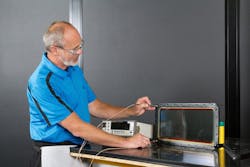PPG Donating Military Coatings, Window for EC-135C Aircraft Restoration
SYLMAR, Calif., Oct. 27, 2016 – PPG (NYSE:PPG) has donated a boom operator compartment side window and will donate military aircraft coatings to the Strategic Air Command & Aerospace Museum, a Smithsonian affiliate in Ashland, Nebraska, for restoration of an EC-135C aircraft that was one of the last to fly as the U.S. Air Force Strategic Air Command’s “Looking Glass.” For retired U.S. Air Force Tech. Sgt. Michael Holloway, command-and-control airplane AF-38049 was the first Looking Glass mission on which he flew. Now a PPG employee, Holloway proposed the idea for the window donation to PPG, and the company decided to donate the coatings, too.
“Upon examination of my flight records I discovered that 049 was my very first Looking Glass Mission on Nov. 11, 1987,” said Holloway, a production employee at PPG’s Huntsville, Alabama, aircraft transparencies plant where the heated window was made to replace a broken one. “Like most Looking Glass missions, it was 8.3 hours in duration, and we took off from and returned to Offutt Air Force Base, Nebraska. Over my three years as a crew member of the Looking Glass, I flew 222 sorties and accumulated 1,910 hours of flight time, and 21 of those sorties were aboard 049.”
“We are very excited to be restoring this important aircraft and grateful for the support of donors like PPG,” said Dr. Michael McGinnis, executive director for the museum. “Looking Glass served an important role in the U.S. strategic deterrence plans and was the reason the U.S. won the Cold War.”
Working with the museum’s restoration team, PPG military coatings experts selected high-solids DESOPRIME™ HS 7233 military epoxy primer to prohibit corrosion and enhance topcoat adhesion, as well as high-solids DESOTHANE® HS 8200 series military and defense exterior topcoat in gray and white to restore the aircraft’s appearance. The PPG protective topcoat affords ease of application, which was important to the museum’s painter, and will create a long-lasting world-class finish.
The boom operator compartment side window is located in the EC-135C’s aft belly, and PPG made the original one as well as the aircraft’s other transparencies. Lying in the compartment, the boom operator would transfer fuel to an aircraft flying behind the EC-135C by “flying” the refueling boom to a receptacle on the receiving aircraft.
“These aircraft served a vital role in the Cold War as a nuclear deterrent,” Holloway said. “I am proud to have been a part of such a historic mission, and I look forward to visiting the museum to see this glorious airplane and possibly volunteering with the restoration in the near future.”
PPG’s global aerospace business offers coatings, sealants, transparencies, packaging and application systems, and transparent armor, as well as chemical management and other services. For more information, visit www.ppgaerospace.com.
About Looking Glass
“Looking Glass” was the nickname given to the Strategic Air Command’s Airborne Command Post, an operation that began Feb. 3, 1961, with at least one EC-135C aircraft in the air at all times on continuous alert. Looking Glass aircraft were airborne 24 hours a day, 365 days a year, for more than 29 years. The aircraft were designed to duplicate, or mirror, underground command-and-control facilities should the ground facilities be destroyed in a nuclear attack.
Aircraft 38049 was retired in 1993 and moved to the Strategic Air Command & Aerospace Museum. In May 2015, the museum began restoring Aircraft 38049 to be an indoor walk-through exhibit, and it is being restored to a 1990 timeframe when it completed and landed its last mission. Complete restoration will take as long as three years, and the museum is in fundraising mode to complete restoration as well as build a world-class exhibit that tells the story of the Looking Glass mission and those who served the mission.
About the Strategic Air Command & Aerospace Museum
The mission of the Strategic Air Command & Aerospace Museum is to preserve the history of Strategic Air Command, the Cold War and aerospace artifacts and to inspire learning through imaginative, innovative, and inspirational programs and exhibits. Located between Lincoln and Omaha, Nebraska, the museum utilizes more than 300,000 square feet of exhibit, education and event space. The museum opened in 1959 to commemorate the aircraft of the Strategic Air Command and moved in 1998 to its current location, a state-of-the-art facility designed to house SAC aircraft and artifacts and provide a venue for the restoration of aircraft, preservation and display of historical artifacts, and the education of future generations in the areas of history, technology and science. For more information, visit www.SACMuseum.org.
PPG: WE PROTECT AND BEAUTIFY THE WORLD™
At PPG (NYSE:PPG), we work every day to develop and deliver the paints, coatings and materials that our customers have trusted for more than 130 years. Through dedication and creativity, we solve our customers’ biggest challenges, collaborating closely to find the right path forward. With headquarters in Pittsburgh, we operate and innovate in more than 70 countries and reported net sales of $14.8 billion in 2015. We serve customers in construction, consumer products, industrial and transportation markets and aftermarkets. To learn more, visit www.ppg.com.
We protect and beautify the world is a trademark and the PPG Logo is a registered trademark of PPG Industries Ohio, Inc.
Desoprime is a trademark and Desothane is a registered trademark of PRC-DeSoto International, Inc.




